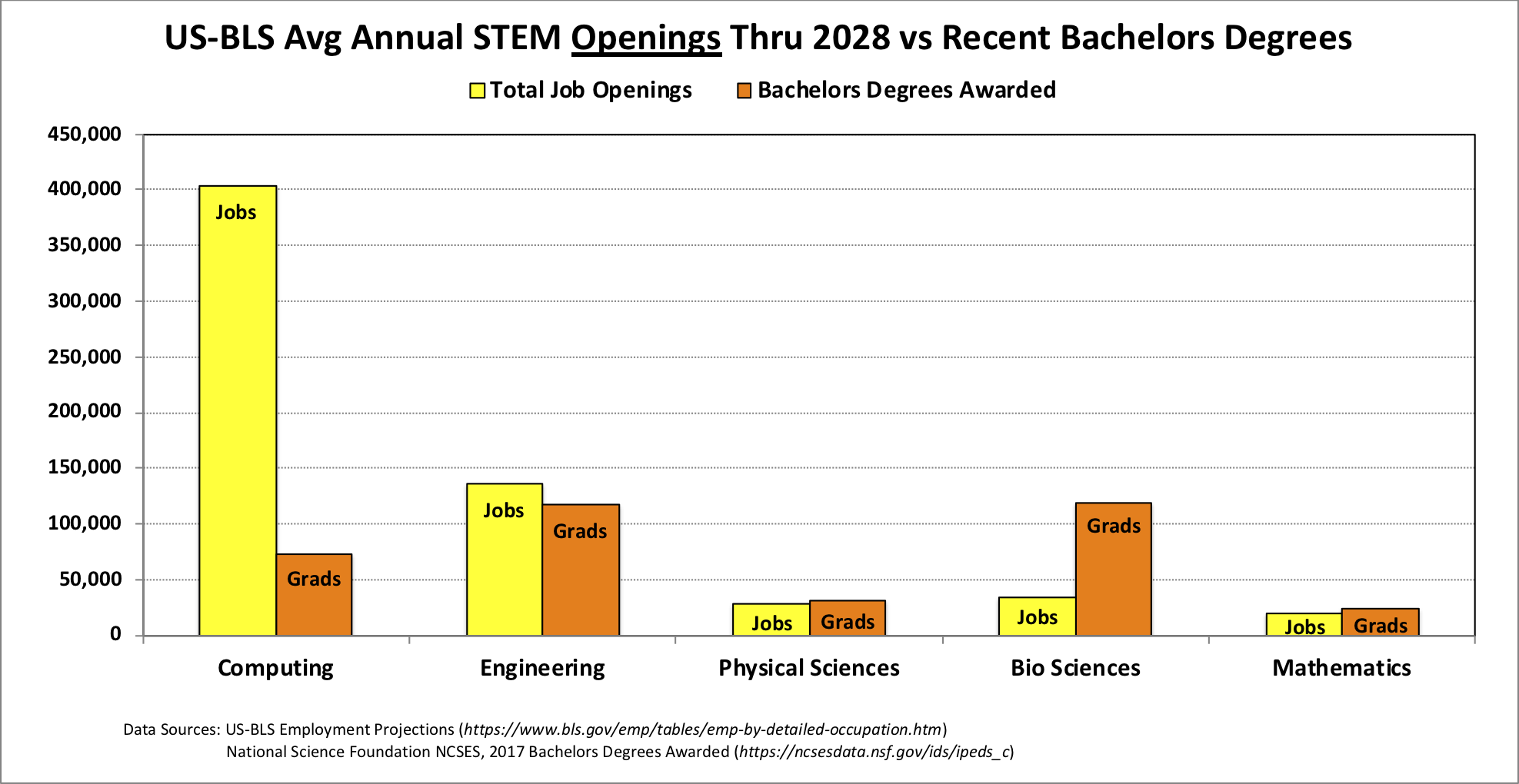
Periodically, the U.S. Bureau of Labor Statistics (US-BLS) releases its employment projections for the next decade. Among other things, the US-BLS produces two sets of employment projections:
• Total Jobs — new jobs plus job openings to replace people who have retired.
In its latest projections, the majority of the STEM career options continue to be in computing. The following figure provides a side-by-side comparison of these US-BLS projections: The left and right charts below present their projections for New Jobs and Total Jobs, respectively:
(Click on either chart for a larger image.)
As shown in the chart on the left, the US-BLS predicts that the five STEM jobs with the most growth will all be in computing, with the majority of those in software development.
More precisely, the US-BLS predicts that each year, there will be nearly 29,000 New Jobs in software development, over 8,300 new computing support jobs, over 5,500 new systems analysts jobs, over 3,500 new information security analyst positions, and over 4,200 other computing-related jobs. No other STEM area is expected to generate even 3000 new jobs per year.
The chart on the right shows that even when retiree replacements are considered, the top five careers with the most Total Job opportunities are in computing: software development, computing support, systems analysts, network/systems administration, and other computing-related occupations. The chart on the right does paint a more encouraging picture for some non-computing STEM careers. However, the contrast between the left and right charts indicates that most of those jobs will be replacing retiring baby boomers, not new jobs created by economic growth.
If we aggregate these US-BLS projections to see the number of jobs per year in each STEM area, we get the following charts:
(Click on either chart for a larger image.)
If we take those numbers and represent them as percentages of all STEM job opportunities, we get the following two charts:
(Click on either chart for a larger image.)
For the foreseeable future of US jobs in science, technology, engineering, and mathematics, more than 3 out of 4 New job openings and more than 3 out of 5 Total job openings are going to be in computing! It is worth mentioning that this is not a fluke — these numbers are fairly consistent with those from two and four years ago.
What kind of “computing” careers are these? The expansion area to the right of each pie-chart breaks down the “computing” job openings into the different US-BLS career categories, and shows the variety of careers that are available for students who study computing. As can be seen in the chart on the left, the US-BLS is predicting that over 40% of the new STEM jobs will be in software development (aka software engineering) alone as compared to about 12% in the combined branches of traditional engineering! With respect to total jobs, the chart on the right predicts that there will be more openings in software development than there will be in all the branches of traditional engineering combined.
Why will there be so many software development/engineering jobs?
- One reason is the mobile computing market. It used to be that every company wanted a website (and they still do), creating demand for web developers. But today, most companies also want apps for smart-phone and tablet devices, whether running Apple’s iOS operating system or Google’s Android operating system. The need to create and maintain these apps is one factor that is creating a huge demand for software developers.
- Another reason is that manufacturers are increasingly embedding computers into appliances like refrigerators, ovens, water heaters, and so on; this is creating the so-called Internet of Things. These computers are being embedded into a wide range of devices, from “smart speakers” (e.g., Amazon Echo/Alexa, Apple Homepod/Siri, and Google Nest/Assistant) to smart thermostats (e.g., Nest) to smart doorbells (e.g., Ring) to the autonomous vehicles currently being designed by automobile manufacturers. All of these embedded computers are little more than paperweights without the software needed to make them do anything useful, adding to the demand for software developers. These embedded computers will communicate by sending data across networks, and this data will be stored in databases, creating demand for networking professionals and database administrators. When things go wrong, the people using these devices will need technical support, creating demand for support specialists.
Together, the IoT and mobile computing are creating a massive demand for people with advanced computing skills, especially in software development.
Note that basic computer literacy (i.e., profic Microsoft Windows, Word, Excel, or Powerpoint) or CAD-design skills will not qualify you for one of these careers. Most of these jobs require advanced computing skills that you will only gain by studying computer science, information systems, software engineering, and/or data science.
When you are trying to get a job, a major consideration is: How much competition is there for the job? To provide some insight into this question, our final chart compares the US-BLS Total Job Openings projections for the various STEM areas against the most recent (2017) National Science Foundation data for the number of bachelors degrees being awarded in those areas.
(Click on the chart for a larger image.)
As can be seen above, the STEM area where the projected openings/grads ratio is highest is Computing, where this ratio is 5.58. (For comparison purposes, this ratio was 5.76 two years ago.)
Market forces seem to be responding to this demand, as CS departments across the U.S. have been reporting a surge in enrollments. Relatedly, for-profit boot camps have sprung up around the U.S., seeking to equip under-employed people with the technical skills needed to secure an entry-level position.
However, these latest US-BLS projections are predicting over 56,000 more computing jobs per year than they were two years ago, and the enrollment surge in colleges and boot camps have a long way to go before they meet this demand. So long as demand continues to exceed supply, the U.S. will continue to experience a shortage of technical talent.
It is also worth mentioning that many employers also place a high value on communication, collegiality, being able to work in groups, and other “people” skills. To maximize one’s career opportunities, a person will need these skills in addition to technical skills. A liberal arts general education is especially good at helping a person develop such skills, specifically: critical thinking, writing, speaking, and giving presentations that communicate to non-technical audiences, such as a typical company’s upper-level management.
In summary, the US-BLS projections tell us that for the foreseeable future, most of the STEM careers are going to be in computing. If you know a young person who is interested in STEM, share this with them and encourage them to seriously consider a career in computing, as that is where the US-BLS predicts most of the STEM career opportunities will be for the foreseeable future.




Join the Discussion (0)
Become a Member or Sign In to Post a Comment